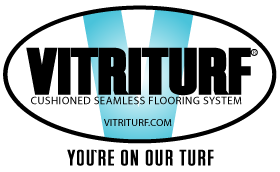Architectural Details | Application | Colors | FAQ

What is SBR?
SBR stands for Styrene Budadine Rubber. It is manufactured as a liquid and poured into molds, generally for the automotive industry. We utilize recycled SBR from tires, hoses and windshield wipers. SBR is utilized in the Base Mat of the Vitriturf Playground System. We offer it as shreds rather than as granules. The shreds make the system more resilient.
What is EPDM?
EPDM stands for Ethyl Propolyne Dione Monomer. It is manufactured as a liquid and then oven dried in sheet form. The sheets for our industry are typically 18” wide by 3′ long. Because it is produced as a liquid, it may be tinted to certain colors. Some pigments hold up well under the Ultra Violet, but others do not such as primary red. The slabs are then granulated to the desired size. The size can vary from .5 mm to 4mm. We utilize .5 to 3mm. The EPDM is utilized in our wearing course. We only use virgin EPDM rather than recycled EPDM. The recycled EPDM looses it characteristics and deteriorates much more rapidly.
What is the difference between Binder and Aliphatic Binder?
The standard Binder is what the industry calls an aromatic binder. This is the binder most of our competitors use for both their base mat and wearing course. Aromatic binders are good, but they do not offer much Ultra Violet protection.
Aromatic binders amber, so when they are mixed with certain colors such as grey, tan, purple and eggshell they cast a yellow appearance. It is fine to utilize aromatic binders in the base mat and colors that will not exhibit much ambering such as red, black, and green. Because aromatic binders do not offer much ultraviolet protection they chalk over time and eventually break down. Once they break down they do not hold the granules together and the system will fail.
Aliphatic binders will provide what the aromatic binder cannot. Aliphatic binders are ultraviolet resistant so the granules remain colorfast. Because the aliphatic binder is ultraviolet resistant it will not break down as fast and will offer a longer life to the system. Because of our introduction of the aliphatic binder to the poured-in-place industry, this binder is now being specified throughout the United States as the preferred binder.
What are acceptable substrates?
The multipurpose system may be applied over concrete, asphalt, or masonry. The playground system may be applied over concrete, asphalt, masonry, or 95% compacted stone. The problem with stone is the compaction rate. If the stone is not properly compacted it will move after a period of time and cause a hollow spot in the Vitriturf System. Our new TK System allows for installation directly over hard pan dirt or grass. Please click on TK System for more information or contact our office at 631.231.1300 x22
In what temperatures may the Vitriturf System be applied?
Temperature affects the system in workability of the materials and the dry time. We prefer to install the system in temperatures above 40 F. The lower the temperature, the thicker the viscosity of the binder, and the harder it is to trowel and longer to dry. The dry time of the binder is dependent on two variables: temperature and humidity. The higher the temperature and humidity the faster it will dry. If you have high temperatures but low humidity, the material will not dry as fast. This is because urethane is moisture cured.
When can we use the playground after the system is installed?
In most cases, the playground can be opened 24 hours after the installation of the system. We prefer 48 hours for sufficient curing of the material. One must consider the time of year and the temperature and humidity before allowing usage of the play area.
Is Vitriturf toxic?
Vitriturf is not “toxic.” Our urethanes are properly labeled for warnings. There is no smell associated with our product and they are 100% solids which means there is no solvent in the product. The only smells emitted during a project would be a rubber smell or diesel fuel. The diesel fuel is utilized as a lubricant for troweling and cleaning the mixer.
How is the system terminated?
The edge of the Vitriturf System should not be left exposed. In situations where an existing edge does not exist a “keyway” should be provided at the termination point. A “keyway” is a saw-cut trench with dimensions of 1/2” wide by 1/2” deep.
